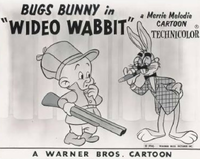Wideo Wabbit
| Wideo Wabbit | |
|---|---|
 Lobby Card | |
| Production company | Warner Bros. Cartoons |
| Distributor | Warner Bros. Pictures The Vitaphone Corporation |
| Release date | October 27, 1956 |
| Starring | Mel Blanc Arthur Q. Bryan Daws Butler |
| Producer(s) | Edward Selzer |
| Music composed by | Carl Stalling |
| Story by | Tedd Pierce |
| Animation | George Grandpré Keith Darling Ted Bonnicksen Russ Dyson |
| Director(s) | Robert McKimson |
| Series navigation | |
| ← Previous | Next → |
| Title card | |

| |
Wideo Wabbit is the four hundred and seventeenth Merrie Melodies theatrical short. It was distributed by Warner Bros. Pictures and The Vitaphone Corporation on October 27, 1956. It was written by Tedd Pierce, produced by Edward Selzer, and directed by Robert McKimson.
When Bugs Bunny learns that the TV Station, QTTV, needs a rabbit for a TV show, he doesn't realize that the role is solely for Elmer Fudd's TV Show, The Sportsman's Hour, where he goes hunting for wabbits.
Detailed summary
Memorable quotes
Bugs (as Morton): Geeze, what a Groucho, VA-VA-VA-VOOM!
Characters
In order of appearance: | ||||||||||
| ||||||||||
Locations
- Earth
- America
- Forest
- Bugs' Rabbit Hole
- QTTV TV Station
- America
Organizations
- The French Fried Fresh Frozen Rabbit Company of Walla Walla, Washington
Objects
- Newspaper
- Ladder
- 10,000 Volt Battery
- Piano
- Dynamited candelabra
- Groucho disguise
- Groucho Glasses (with eyebrows and stache)
- Groucho's Cigar
- Norton Disguise
Production
Development
Filming
Music
The music was composed by Carl Stalling.
This was the last time Bugs Bunny's theme, What's Up Doc? was used for the title sequence. Starting with To Hare Is Human, all Bugs Bunny cartoons would use different title themes.
Also, a music cue from A Wild Hare is reused in this cartoon when Elmer follows the wabbit twacks.
Release
Dates are in order of release:
- United States: October 27, 1956 in theatres
Behind the scenes
- The title is a Elmer Fudd-ese pun of 'Video Rabbit' only the 'V' and 'R' are replaced with W's.
- The working title was Omni Bunny, which is a pun of omni man.
- This short updates Bugs' design on the Bugs Bunny introductionary card for the first time since Hare Trigger, which would be used up to False Hare (1964).
- When Bugs impersonated the voices of both Groucho Marx and later Ed Norton from The Honeymooners in two scenes, Mel Blanc did not provide the voices in those two sequences; instead Daws Butler provided those voices. Blanc admittedly found himself to be terrible at celebrity voice impersonations, despite the fact that his Pepe Le Pew and Foghorn Leghorn characters are based on celebrity impressions.
- Also, this is the second time that Bugs has played Groucho Marx to avoid Elmer. The first time was Friz Freleng's cartoon Slick Hare (1947), but Elmer comes much closer to catching Bugs in that Groucho scene than in the one in Wideo Wabbit by means of disguise as Groucho's brother Harpo.
- The animation of Bugs as Liberace playing Hungarian Rhapsody No. 2 on the piano and getting his fingers tied in a knot is reused from Rhapsody Rabbit (1947). Coincidentally, Tedd Pierce cowrote that cartoon with Michael Maltese.
Everlasting Influence
- Station QTTV would be seen again in two more shorts: The 1959 Merrie Melodies cartoon, People are Bunny, and the 1963 Looney Tunes cartoon, The Million Hare.
- Additionally, People are Bunny would also reuse some elements from this short. However, Daffy Duck would take Elmer's place in said short.
- This short was used in the TV Special, Bugs Bunny's Mad World of Television.
Critical reception
In other languages
| Language | Name | Meaning |
|---|---|---|
Home availability
- In the United States:
